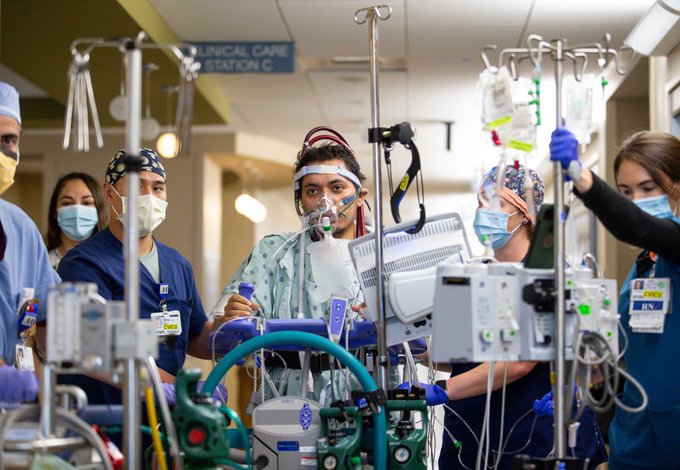ECMO as a bridge to lung transplantation for Covid-19 ARDS patients at Houston methodist hospital
Dewei Ren1, Lin-Chiang Philp Chou1, Erik Suarez1, Thomas Macgillivray1.
1DeBakey Heart & Vascular center, Houston Methodist Hospital, Houston, TX, United States
Introduction: During the pandemic, the use of ECMO support and bridging to lung transplant increase substantially in severe COVID-19 adult respiratory distress syndrome (ARDS) patients. We report thirteen cases from our institute in which the patients were treated with veno-venous (VV) ECMO for severe ARDS from COVID-19 infection and successfully received bilateral lung transplant in 2021.
Method: A total of 71 lung transplants were performed at our institution in 2021, including 17 lung transplants for severe COVID-19 ARDS. 13 of these 17 patients were cannulated for VV ECMO, either VV-ECMO plus mechanical ventilation, or VV-ECMO only. Demographics, clinical characteristics and outcome were analyzed.
Results: All patients were male with median age 42 years (24-60 years). The median BMI of the recipients was 26 (21-34). The median lung allocation score (LAS) was 90 (89-95). 6 patients had no prior remarkable past medical history, 7 patients had known comorbidities including hypertension, type II diabetes mellitus, chronic kidney disease and/or chronic heart failure. None of patients had underlying lung disease. Eleven recipients received bilateral lung transplants and two recipients received bilateral lung transplant plus a kidney transplant. The median bridging time on ECMO was 91 days with a range of 49 to 170 days. Femoral-femoral VV ECMO cannulation was initiated urgently in most patients. Once the patients were stabilized, the VV ECMO configuration was converted to Protek Duo (n=8), Avalon (n=2), or Crescent cannula (n=2) and one patient continued on femoral-jugular VV ECMO (Figure 1). At the time of transplant, 2 patients were supported with mechanical ventilation via tracheostomy in addition to ECMO, 6 patients had tracheostomy in addition to ECMO, 5 patients were on ECMO only. Total 11 patients were “awake ECMO”, all participated physical therapy (7 patients ambulated daily). Pre-transplant, the average hospital length of stay (LOS) was 64 days (9-141), the average ICU LOS was 17 days (7-47). The total LOS was 91 days (43-122). Complications during ECMO treatment included gastrointestinal bleeding, septic shock, acute kidney injury, right ventricular failure, pneumothorax. Post-transplant complications, such as AKI, RV dysfunction, pericardial effusion, dysphagia, gastroparesis, appear to have similar incidence as in non COVID-19 lung transplant population. 12 patients were decannulated from ECMO during the transplant procedure, one patient was re-cannulated for VV-ECMO due to aspiration and decannulated after three days. 4 patients discharged home; 8 patients were transferred to rehabilitation facilities. One patient died 7 months post-transplant with pneumonia, sepsis and multi-organ failure.
Conclusion: The prolonged VV-ECMO support is feasible for highly selected patients who are eligible to be bridged to lung transplantation. Awake VV-ECMO and prehabilitation are good prognostic indicators for patients who can benefit from lung transplant.


right-click to download
